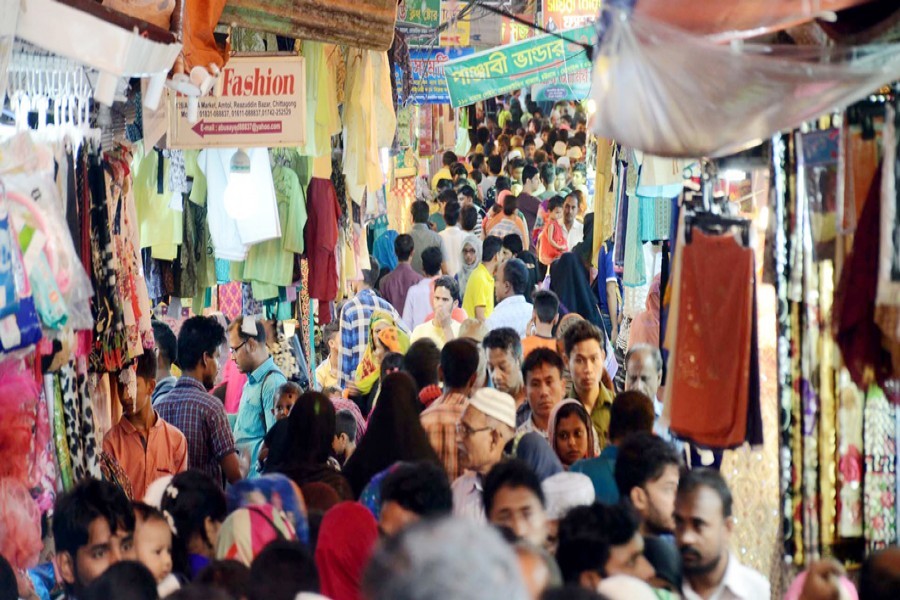Fahim Hridoy, who owns a fast food shop in Dhaka city’s Tejturi Bazar, has plans to buy some warm clothes soon for himself. When asked from where, he was quick to say, “New Market”.
Despite the fact that the city offers a wide array of modern shopping centres and malls, why did he mention the “old” New Market?
“Though it is crowded and not so good looking, New Market makes me feel at home, gives me a breather like my own place,” Fahim told The Financial Express. Not just him, many others feel the same for old traditional city markets. Let us find out more about them.
Traditional city marts
Some people prefer shopping in their very familiar shops where they have been doing this generations after generations. Some, on the other hand, opt for newly established superstores and mega malls. This choice is all up to an individual’s perspective of shopping: needs, expectations, and preferences. Price of products, quality, abundance and bargaining opportunity play vital roles in choosing where to shop. The traditional city markets are still on people’s choice list as they hold on to their age-long popularity. Usually New Market, Gausia Market, Chandni Chowk, Nurjahan Super Market, Badruddoja Market, Nilkhet, Aziz Super Market and Bongo Bazar, among others, can be referred to as traditional city marts. Outside Dhaka, there are district-wise New Markets and other traditional markets which are also famous. These shopping centres, even after being so old and sometimes battered, have remained an ultimate shopping option for a large number of people with no potential alternative.
Haggling opportunity
One of the main reasons for choosing these markets is the opportunity of bargaining. Haggling before purchasing anything is part of our culture for a long time. Many shoppers find personal satisfaction through buying something after a successful haggle. It is not possible at shopping malls and fixed price shops.
“I just love to bargain,” said Aruneka, who works as a quality control officer for a pharmaceutical company. Being a regular customer of New Market and Gausia, she believes, bargaining enables her to buy products aligned with her financial capacity. “I can purchase products at a reasonable price from New Market as it allows me to haggle. Thus I can buy my desired product at a lower price,” she explained. Needless to say, Aruneka iterated the voice of numerous other city market-goers.
Decent quality
When it comes to buying products, quality may be the number one priority. Sadia Sharmin, a regular customer of New Market, shared the same interest. The Shamsunnahar Hall resident of Dhaka University said if she buys things after some research, she hardly becomes disappointed. Another like-minded customer Zahin Ahmed, a student from Bangladesh University of Professionals (BUP), stated the same. “These places, I think, have really good collections of products and these are of good quality as well,” he said.
Transcending generations
Most of the mentioned city markets were established in a period between 1950s and 1980s. And the previous generations of shoppers had these places as their only go-to places. Many of them have not been able to brush off this habit. “I used to shop from Bongo Bazar with my mother. We still do the same, but with my daughter,” said Rikta Khandaker, a housewife from Dhaka’s Bangshal area. Thus, these not so good-looking markets are going strong from generations after generations.
According to Jubaida Nasreen, who is a regular visitor to Noorjahan Market, the place is very much dear to her since it gives her a chance to connect to the memories of her parents and grandparents. “Despite my residence being in Uttara and having many good shopping malls there, I still come to these places as my parents used to shop from here,” said the new graduate from Islamic University of Bangladesh (IUB).
Concerns
However, some complaints can also be heard even from the loyal customer base. One of the main concerns is the unorganised setting of the marketplace. Normally these shopping places consist of many small and temporary stalls. These stalls are seldom arranged according to the type of products. As a result, searching for a particular item and further comparing and bargaining become a bit difficult. Hence, many of the customers have suggested if the stalls were arranged in the reversed manner, their shopping would be much easier.
Another concern is the lack of renovation and maintenance. The customers are concerned that if this particular aspect is not given proper attention by the authorities, a time may come when these traditional marts would become unworthy of shopping. Lastly, the customers want to make their shopping experience better. Hence, they have suggested the installation of air conditioners, proper ventilation system, and the active presence of a cleanliness team at these marketplaces.
For the city dwellers, these old markets are much more than mere shopping places. They are part of the city’s heritage. Hence, attempts should be taken to save and enhance the glory of these places. People's current expectations towards these places are concerned less with basic needs but more with personal satisfaction. Given the fact that these places have seamlessly served all types of expectations of people, they deserve minimum attention from the authorities so that they can survive some decades more.
Rifah Nawar is a student of Institute of Business Administration, Dhaka University.


